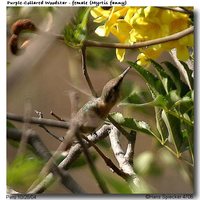|
| Query: bird | Result: 9374th of 32675 | |
Purple-collared Woodstar - Myrtis fanny

| Resolution: 534x534
File Size: 83999 Bytes
Date: 2004:10:28 08:24:55
Camera: Canon EOS 10D (Canon)
F number: f/5.6
Exposure: 1/250 sec
Focal Length: 400/1
Upload Date: 2008:07:15 16:34:54
|
|
|

